Etsy to Shopify Migration: The Most Detailed Guide (2024)
Are you considering moving your store from Etsy to Shopify? Perhaps you’re tired of paying high fees on Etsy or feel limited by the platform’s customization options. Whatever your reason, the good news is that the transfer from Etsy to Shopify process is relatively straightforward. In this guide, we’ll walk you through it. In this guide, we’ll walk you through:
- 7 steps to import your Etsy store to Shopify
- Reasons why you should migrate from Etsy to Shopify
Exclusive Offer: Get Shopify 33 days for just $1 + The Online Store Starter Kit
Start your 3-day free trial, and enjoy your first month of Shopify for $1 plus the premium package designed especially for new Shopify merchants!
Types of data you can transfer from Etsy to Shopify
Here’s a quick rundown of what you can transfer from Etsy to Shopify:
Product information, including:
- Name
- SKU
- Full Description
- Special Price
- Variants (SKU, Weight, Attributes, Quantity, Price, Special Price, Name)
- Additional Images
- Quantity
- Product Image
Product Categories:
- Name
It’s worth noting that not all data can be migrated between platforms. For example, reviews and ratings from Etsy cannot be transferred to Shopify. You may also need to manually recreate your store’s branding, such as your logo and color scheme, on Shopify.
Three ways to transfer from Etsy to Shopify
Pros & Cons
Each method for migrating from Etsy to Shopify has its own advantages and disadvantages. It is important to take into account your budget, time constraints, and level of expertise before making a decision.
| Methods | Pros | Cons |
|---|---|---|
| Manually migration |
|
|
| Using an importer app |
|
|
| Hiring an expert |
|
|
Who is each migration method from Etsy to Shopify for?
Each migration method from Etsy to Shopify is suitable for different types of sellers depending on their level of technical expertise, budget, and the size of their store.
Manually Migrate from Etsy to Shopify:
- For those who want complete control over the transfer process.
- For those who want to avoid additional costs.
- For those who don’t have much data to transfer.
Use an Importer App to Migrate from Etsy to Shopify:
- For those who want automatic data mapping and customization options.
- For businesses with a large volume of data that require an accurate and quick transfer.
Hire an Expert to Migrate from Etsy to Shopify:
- For medium to large businesses that have a large budget.
- For medium to large businesses that have a massive amount of data and want a correct and speedy transfer.
- For those who want advice on best practices and help to optimize the new store.
Related posts
Etsy to Shopify Migration: Our Step-by-Step Guide
Step 1: Sign Up for Shopify
If you’re new to Shopify, you’ll need to create a Shopify account first. You can start a 3-day free trial, which allows you to set up your account quickly without committing to a plan just yet.
- Go to shopify.com > click Start free trial
- Click I'm already selling online or in person
- For the question “Are you currently selling through another platform?" > select Etsy
- "Where you would like to sell" > Select An online store or whatever suits you
- “What do you plan to sell first?” > Choose your product type.
- Add your store name and location
- Use an email to register
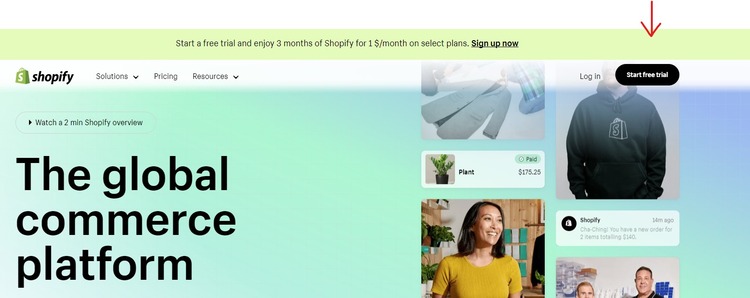
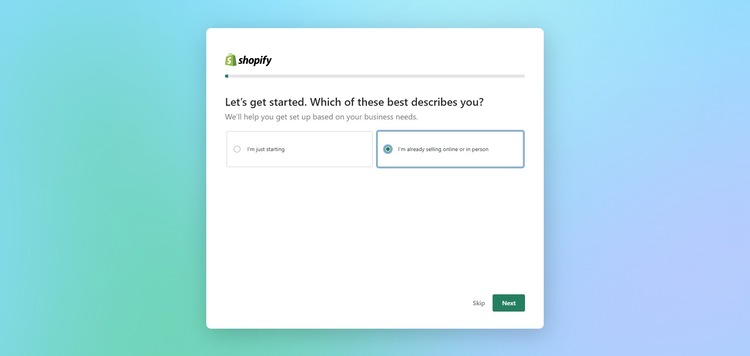

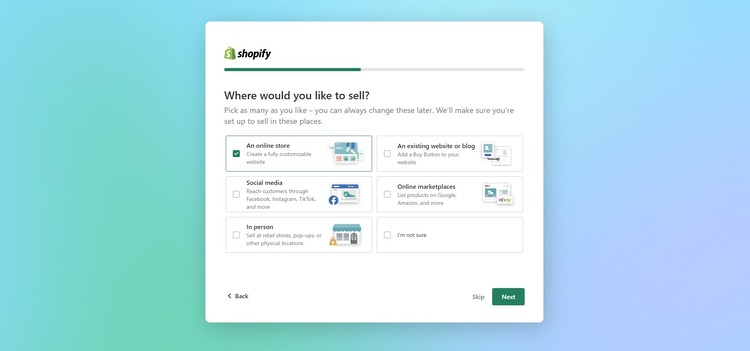
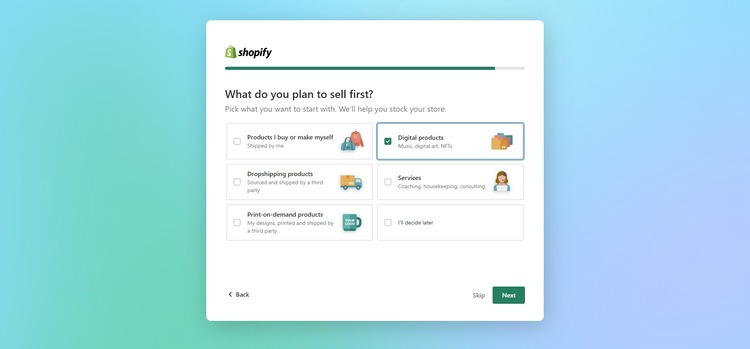
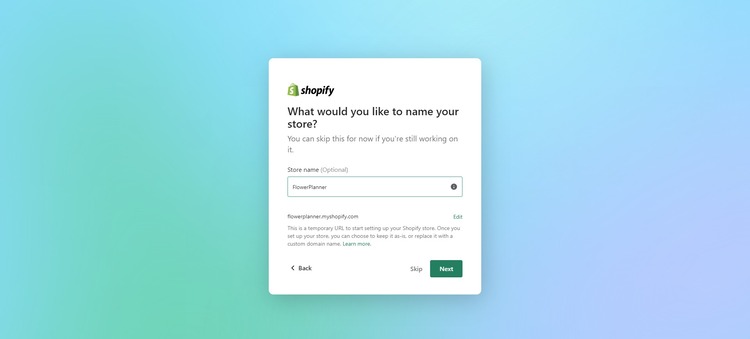
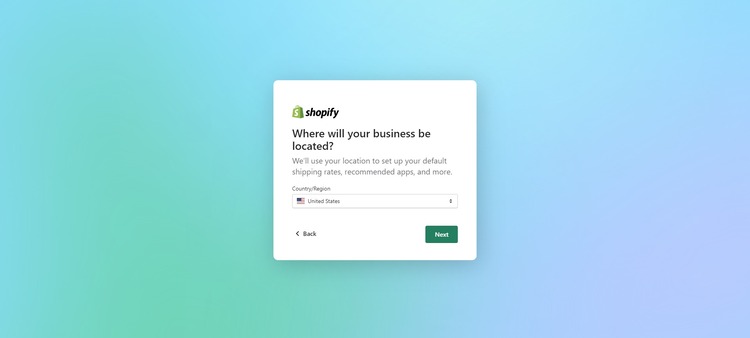
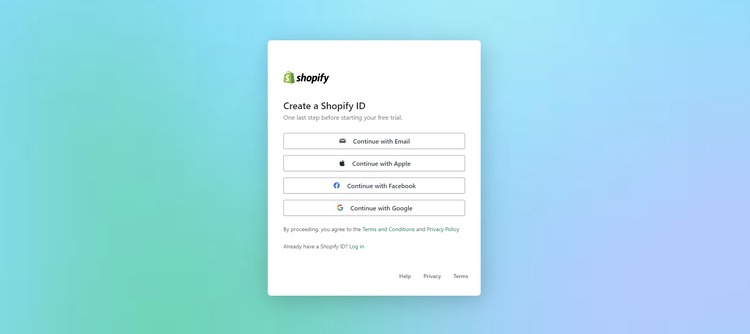
After that, you’ll be directed to Shopify Dashboard. The account is ready to go.
As you choose Etsy in Step 2, the Setup guide to making a switch from Etsy to Shopify will now show up on the dashboard.</li>
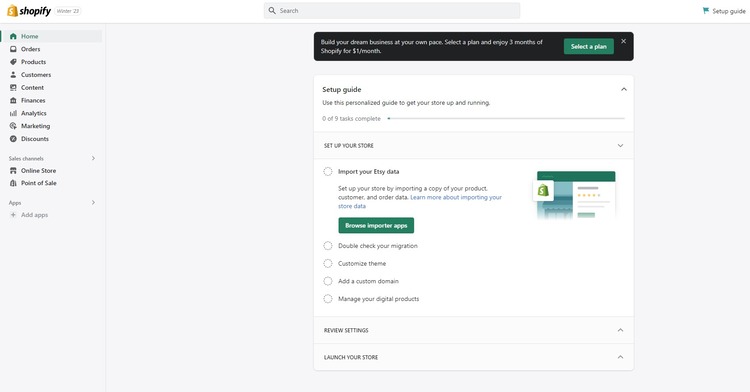
If you’re ready to start an online business on Shopify, you may consider the pricing plan. Now, you need to research Shopify pricing plans and features.
Currently, Shopify offers 3 main subscription plans:
- Basic Plan: $39 per month
- Shopify Plan: $105 per month
- Advanced Shopify Plan: $399 per month
The higher the price of the plan, the more advanced ecommerce features it includes.
Step 2: Set Up Your Basic Information
To run your store and make sales, you’ll need to set up the essentials. They are your basic information, payments, and shipping.
Set up payments:
- Go to Settings at the bottom left corner > Click Payments
- Set up Shopify Payments and/or a third-party payment provider
Set up Shipping:
- Go to Settings > Click Shipping and Delivery
- Click Add rate > Choose Set your own rates or Use carrier or app to calculate rates
Step 3: Export your Etsy store data
Now that your Shopify store is set up, it’s time to export your Etsy data.
- Log in to your Etsy account and click Shop Manager in the top right corner.
- Click Settings > Options > Download Data
- Click Download CSV.
To download Orders, you must select a CSV type, and at least the year you want to take the data.
After selecting the type of CSV and the time you want, click Download CSV to start downloading each type of CSV file.
However, you need to note that:
- You can download as CSV files these types of data: Currently for Sales Listings, Orders, Shop Settings, and Reviews.
- You can’t download your customer data directly from Etsy.
- Shopify only accepts the import of products, customers, inventory for manual migration. That means you can’t import manually Orders, Shop Settings and Reviews.
Step 4: Import your Etsy data into Shopify
Method 1: Import manually
Go to Shopify Dashboard > Click Products > Click Import in the upper right corner.
As you click Import, a new box will appear.
From the “Add File” section, drag and drop the CSV files directly into this section.
You can only upload one file at a time.
Once you’re done uploading these three files, all your products, images, descriptions, titles, and tags will appear under the “Product” section, and you can find your existing orders, and analytics too.
NOTE:
Shopify provides sample CSV templates for products and customers, but if you are importing data from Etsy, you may need to modify your exported files to match the format of the Shopify sample file.
Method 2: Use an importer app
To import your existing listing data, order history, and current orders, you can use an Etsy importer app. You can choose from the list Shopify suggests or go to Shopify App Store to pick one. There are a number of options available.
Migrating from Etsy to Shopify can be a daunting task, but using an importer app can simplify the process. Here are some steps to migrate using an importer app:
- Choose the right importer app: There are many paid importer apps available in the Shopify app store. But two of the most popular apps are LitExtension and Cart2Cart. You can choose a free app—Transporter—but this app is only available for Shopify Plus merchants.
- Sign up for an importer app: Choose a reputable importer app, such as LitExtension or Cart2Cart, and sign up for their services.
- Provide necessary details: Provide the necessary details, such as your Etsy and Shopify store credentials, to allow the importer app to access and migrate your data.
- Select the data to migrate: Choose the data you want to migrate, such as products, customers, orders, and reviews. Most importer apps offer data mapping and customization options to ensure a seamless transition.
- Test the migration: Before starting the actual migration process, run a test migration to check if everything is working as expected.
- Start the migration: Once you’re satisfied with the test migration, start the actual migration process. The time it takes to complete the migration depends on the amount of data being transferred.
- Check and review your data: Once your data is imported, check and review it to ensure everything is in place. Make any necessary adjustments or corrections.
Method 3: Hire an expert
Hiring an expert to migrate from Etsy to Shopify can help ensure a smooth transition and minimize any potential issues or errors.
You can find an expert to migrate your store from Etsy to Shopify on various freelance marketplaces such as Upwork, Freelancer, Fiverr or on the Shopify Experts Marketplace. You can also ask for recommendations from fellow sellers or seek referrals from Shopify communities or groups on social media.
Here are some tips on how to find the right Shopify expert for your needs:
- Look for experienced experts: Find an expert with experience in Shopify and a track record of successfully migrating other Etsy sellers to Shopify..
- Check their portfolio: Review the expert’s portfolio and testimonials from previous clients to get an idea of their work quality and client satisfaction.
- Consider communication: Ensure the expert is responsive and communicates effectively throughout the migration process to address any questions or concerns that may arise.
- Discuss the timeline and budget: Have a clear understanding of the expected timeline and budget for the migration project before hiring the expert.
- Check for additional services: Some experts may offer additional services such as store setup, customization, and optimization. Consider these services if they align with your business goals and needs.
Step 5: Review your product data
Review and update your product listings: After migrating your products from Etsy to Shopify, take the time to review and update your Etsy listings to ensure that they are accurate, complete, and optimized for search engines. Make sure to add high-quality product images, detailed descriptions, and relevant keywords.
To do this, go to “Products” in the left-hand menu. Here, you can review and update each product as needed.
Step 6: Test and run your Shopify store
With your Etsy data imported and your products updated, it’s time to launch your Shopify store. To do this, click “Settings” in the left-hand menu and click “Sales channels”. Here, you can preview your store and check if it’s ready to be public.
Besides, there are several things for you to set up before your site is live.
- Products and collections: Ensure that all your products and collections have been imported correctly and are displayed correctly in your new store.
- Payment and shipping settings: Review and adjust your payment and shipping settings if necessary.
- Taxes: Make sure that all taxes are set up correctly.
- Design and theme: Check your store’s design and theme, and make any necessary adjustments to ensure your new store looks great and functions well.
Step 7: Train your staff on the new platform
Here are steps you can take for staff training after migrating from Etsy to Shopify:
- Provide hands-on training sessions to familiarize staff with the Shopify interface and features.
- Create training materials such as user manuals or video tutorials to supplement in-person training.
- Encourage staff to ask questions and provide feedback during the training process.
- Assign a designated point person who can answer any questions or concerns that may arise during the transition period.
- Schedule regular check-ins to ensure that staff are comfortable with the new platform and to address any ongoing issues or questions.
Step 8: Promote your new store on social media and other channels
After migrating your store to Shopify, it’s time to let your customers know about the replatforming and your new online store. Promoting your new store on social media channels can help you reach out to your customers and get them excited about it. You can also use other marketing channels like email campaigns, online ads, or influencers to promote your new store.
By following these tips, you can find a reputable expert who can help make the migration from Etsy to Shopify a smooth and successful process for your business.
How much does it cost to transfer from Etsy to Shopify?
The cost of Etsy to Shopify migration may vary depending on the chosen method and the level of customization required. If you use a third-party migration app or hire Latam software developers to manage the migration process may involve some associated costs.
For instance, the app we use to import data from Etsy to Shopify in this post—Easy Import ‑ Etsy Migration—charges you $0.2 per imported listing.
Hiring a developer is also an option, but the cost will depend on their hourly rate and the complexity of the migration.
Transfer from Etsy to Shopify: How to save costs
With some careful planning, you can save costs during the migration process. Here are a few tips to help you save money when migrating from Etsy to Shopify:
- Choose the right plan: Shopify offers different pricing plans depending on your business needs. It’s essential to choose a plan that fits your budget and business requirements. Start with a basic plan and upgrade as your business grows.
- Use free themes: Shopify offers a wide range of free themes that you can use to design your store. Instead of hiring a designer to create a custom theme, consider using a free theme and customize it to fit your brand.
- Import products manually: Instead of using an importer app or hiring an expert, consider importing your products manually. It may take more time, but it’s a free option that can save you money.
- Use free apps: Shopify has an extensive library of free apps that you can use to enhance your store’s functionality. Instead of paying for expensive apps, consider using free apps to save costs.
- Minimize marketing expenses: Instead of spending a lot of money on marketing, focus on building your brand organically. Utilize social media platforms to reach out to your audience and use email marketing to keep your customers engaged.
By implementing these cost-saving measures, you can migrate from Etsy to Shopify without breaking the bank. Remember, it’s essential to budget your expenses and plan accordingly to ensure a smooth transition.
Can You Sync Etsy to Shopify?
The answer is yes. It is possible to sync your Etsy shop to Shopify. You can connect your Shopify account and Etsy account using the Etsy Integration and Sync app. This will save you time as you only have to upload Etsy listings once, and they will automatically get uploaded to both platforms.
When should you transfer from Etsy to Shopify?
Here are the signs you need to switch from Etsy to Shopify:
- Your business is growing, and you need more customization options and features that Etsy cannot provide.
- You want more control over your brand and website design.
- You want to avoid Etsy’s fees, which can add up quickly as your business grows.
- You want to sell on multiple channels, including your own website, social media, and marketplaces other than Etsy.
- You want to use third-party apps and integrations to optimize your store and improve your sales and marketing efforts.
- You want to own your customer data and have more flexibility in how you communicate with your customers.
- You want to have access to more advanced analytics and reporting tools to better understand and optimize your business performance.
Why do you need to transfer from Etsy to Shopify?
Etsy might no longer work for you
There could be various reasons why Etsy might no longer work for a seller.
Sellers who come to Etsy could find it to be an easy and affordable platform with a large customer base and a low-barrier entry into e-commerce for small businesses and individual sellers. However, that may no longer be what attracts sellers. Here’s why:
One of the main reasons is the high fees that Etsy charges:
- Listing fee: $0.20 per listing
- Transaction fees: 6.5% + at least 3% + 25¢
This can cut into a seller’s profits, which can be especially challenging for small businesses or those just starting out.
Additionally, Etsy’s policies and guidelines may not align with a seller’s business goals or vision. For example, Etsy has restrictions on the types of products that can be sold, as well as unreasonable suspensions (they even suspend accounts of established Etsy sellers). This can be frustrating.
Another reason is the lack of control over the design and branding of the store. Etsy provides limited customization options, which can make it difficult for sellers to create a store that truly reflects their brand. That’s why many find having their own website a more sustainable option.
Finally, some sellers may outgrow Etsy’s platform and need a more robust solution to support their growing business needs. In such cases, migrating to a platform like Shopify can offer more flexibility, control, and growth opportunities.
What are the benefits of migrating from Etsy to Shopify?
Migrating from Etsy to Shopify can offer several benefits to online sellers. Here are some of the key advantages:
- Shopify has lower fees. Despite the upfront costs, the transaction fees Shopify charges are way lower than Etsy.
- You have complete control over your customer lists and can engage directly with them.
- There is lower direct competition than in the Etsy marketplace.
- You can promote and cross-sell your items.
Conclusion
That’s basically how to migrate from Etsy to Shopify. Etsy to Shopify replatforming could be a great change to have more control over your shop and increase profits. By migrating to Shopify, sellers can take advantage of a range of features and tools to enhance their online presence and expand their customer base.





